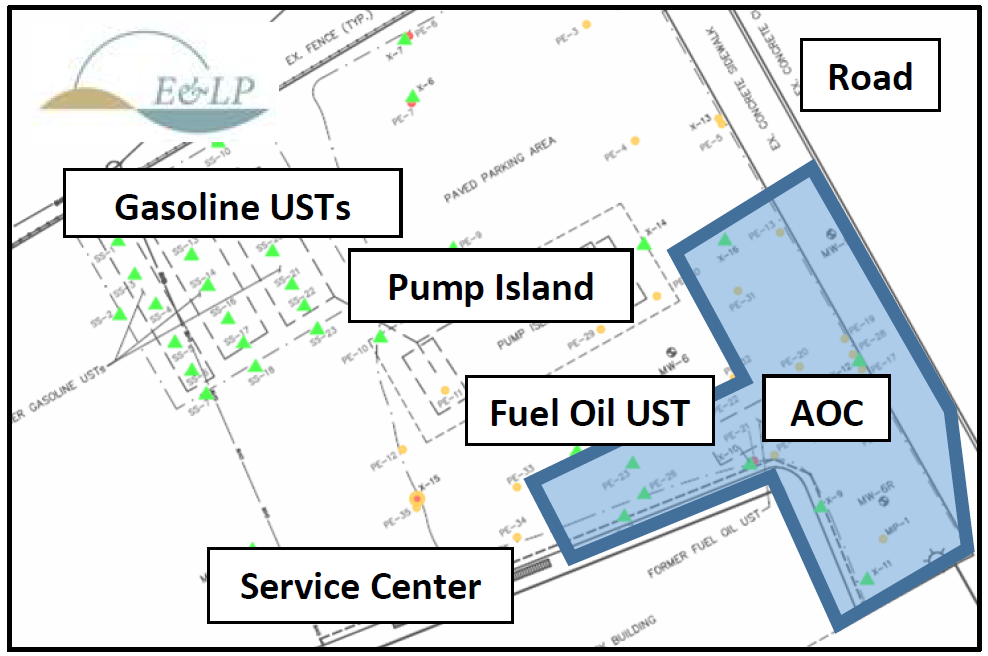Former Gasoline Station – Madison, New Jersey
Provect-OX® – In Situ Chemical Oxidation + Enhanced Bioremediation for Source Area Remediation
Site: Former Gasoline Station – Madison, New Jersey
Constituents of Interest: LNAPL, BTEX, and TMB
Project Summary
At a former gas station in Madison, New Jersey, in situ remediation was applied to address petroleum hydrocarbon source mass within the subsurface smear and saturated zones. Excavation of gasoline and fuel oil underground tanks (USTs) along with the associated piping and shallow hydrocarbon soil impacts had previously been completed. However, excavation was impacted due to accessibility limitations from the service center building and road. Following excavation and enhanced fluid recovery activities, residual benzene, toluene, ethylbenzene, xylene (BTEX), trimethylbenzene (TMB), and light non-aqueous phase liquid (LNAPL) impacts remained. The primary area of concern (AOC; Figure 1) was approximately 1,500 sq ft with a 15-ft vertical target interval from approximately 25 to 40 feet below ground surface (bgs). The geology at the site is dense silt and clay with depth to groundwater at 30 ft bgs. The in situ injection program targeted the BTEX, TMB, and LNAPL with Provect-OX® (US Patent 9,126,245), which is a catalyzed chemical oxidation process that leverages enhanced bioremediation post-oxidation.
Figure 1: Site Map

Remediation Plan
The remedial program was developed by Engineering & Land Planning Associates, Inc. (E&LP) and Provectus Environmental Products, Inc. (Provectus) with in situ implementation provided by Innovative Environmental Technologies, Inc. (IET). A total of 13,300 lbs of Provect-OX® were applied via 20 temporary direct push injection locations to treat the AOC and two impacted monitoring wells. The service center remained open and active during drilling and injection activities.
Provect-OX® rapidly oxidizes the organic contaminants present in soil and groundwater and provides long-term, sustained secondary bioremediation to manage residuals and prevent contaminant rebound. This is accomplished by using ferric iron (Fe III) as a safe and effective means of activating persulfate, which quickly yields sulfate and ferrate (site-specific) radicals for chemical oxidation treatment. A pH buffer is also preblended with the Provect-OX® to offset any post-injection acidic pH conditions that are normally observed with traditional persulfate applications. The technology process enhances subsequent utilization of sulfate and iron as terminal electron acceptors for facultative redox reactions to support secondary biodegradation of any residual contaminant mass.
Treatment Program Results
Field and geochemical data for the two target monitoring wells are presented below in Table 1 and Table 2. Volatile organic compound (VOC) data for the monitoring wells are presented in Table 3 and Table 4. Chemical oxidative conditions are evident during the first MW-6R and MW-9 post-treatment sampling event with increased ORPs of +354 mV and +32.6, respectively. The presence of persulfate, sulfate, and iron in groundwater confirmed that Provect-OX® was successfully distributed within the targeted area. The included pH buffer component of the product offset production of sulfuric acid that is created due to persulfate activation (e.g., common persulfate applications exhibit pH <4). During the November 2019 sampling event (3 months post-injection), the ORPs in both wells are negative with transition back to a reducing environment starting to occur.
Table 1. Field and Geochemical Data for MW-6R
 *Minimum detection limit of 109 mg/L
*Minimum detection limit of 109 mg/L
Table 2. Field and Geochemical Data for MW-9

Following the Provect-OX® application, petroleum hydrocarbon groundwater concentrations have significantly decreased (Table 3 and Table 4). MW-6R exhibited >89% reduction concentrations for all target VOCs other than ethylbenzene (>68% decrease). The VOC reductions in MW-9 were >88% and LNAPL has been eliminated. Additional contaminant concentration decreases in MW-6R and MW-9 are anticipated due to the iron and sulfate enhanced bioremediation processes.
Table 3. VOC Data for MW-6R
 ND: Non-Detect
ND: Non-Detect
Please contact Will Moody at (908) 581-6291 or via email for additional information regarding this project or our technologies. Furthermore, Troy Lizer can be reached at (303) 284-7428 or via email.
Click Here for a site evaluation, conceptual remedial design, or material cost estimate with turn-key alternatives available upon request.



